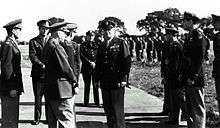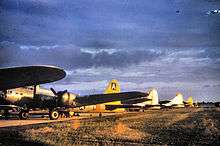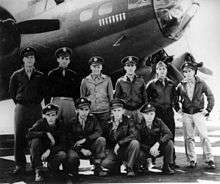RAF Bury St Edmunds
| RAF Bury St Edmunds RAF Rougham USAAF Station 468 .png) | |||||||||||
|---|---|---|---|---|---|---|---|---|---|---|---|
| Near Bury St Edmunds, Suffolk in England | |||||||||||
|
Bury St Edmunds/Rougham Airfield - 6 June 1955 | |||||||||||
 RAF Bury St Edmunds Shown within Suffolk | |||||||||||
| Coordinates | 52°14′39″N 000°45′44″E / 52.24417°N 0.76222°ECoordinates: 52°14′39″N 000°45′44″E / 52.24417°N 0.76222°E | ||||||||||
| Type | Royal Air Force station | ||||||||||
| Code | BU | ||||||||||
| Site information | |||||||||||
| Owner | Air Ministry | ||||||||||
| Controlled by |
Royal Air Force United States Army Air Forces | ||||||||||
| Site history | |||||||||||
| Built | 1941 | ||||||||||
| In use | 1942–1948 | ||||||||||
| Events |
European Theatre of World War II Air Offensive, Europe July 1942 – May 1945 | ||||||||||
| Airfield information | |||||||||||
| Elevation | 63 metres (207 ft) AMSL | ||||||||||
| |||||||||||
Royal Air Force Bury St Edmunds or more simply RAF Bury St Edmunds is a former Royal Air Force station located 3 miles (4.8 km) east of Bury St Edmunds, Suffolk, England. Not to be confused with the RAF grass strip on the western side of Bury St Edmunds known as RAF Westley, an area now part of the town itself. The airfield, now in private ownership and much reduced in size, is still active and is known as Rougham Airfield.
History
The airfield was originally and is now again known as Rougham as it is located north of that village between the A14 and the main railway line between Bury St Edmunds and Ipswich. It was built during 1941 and 1942 with three intersecting concrete runways. The main runway of 2,000 yards was aligned approximately E–W.
As the airfield was designed for a United States Army Air Forces (USAAF) bomb group, fifty concrete hardstands were constructed off the encircling perimeter track. Two T2-type hangars were erected, one on each side of the airfield. The technical site was on the southern side of the A14 and most of the living sites dispersed in woodland south of the main road around the village of Rougham. Accommodation was provided for some 3,000 personnel in Nissen and other temporary type buildings.
United States Army Air Forces use


The airfield was opened in September 1942 and was used by the USAAF Eighth Air Force. Bury St Edmunds was given USAAF designation Station 468 (BU).
USAAF Station Units assigned to RAF Bury St Edmunds were:[1]
- 453d Sub-Depot (VIII Air Force Service Command) [2]
- Signal Depot S_800[3]
- 18th Weather Squadron
- 6th Station Complement Squadron
- Headquarters, 4th Combat Bombardment Wing, 13 September 1943 though 18 June 1945
- 36th Signal Construction Battalion
- 850th Signal Service Battalion
- 1138th Quartermaster Company
- 16th Special Services Company
- 1734th Ordnance Supply & Maintenance Company
- 839th Signal Service Company (Air Operations)
- 979th Military Police Company
- 982d Signal Service Company
- Company B, 850th Signal Service Battalion
- 2025th Engineer Fire Fighting Platoon
- 217th Finance Section
- 101st Signal Corps Inspection & Maintenance Team
- 19th Signal Center Team
- Advance Detachment (36th Signal Construction Battalion)
- Detachment A (850th Signal Service Battalion, Company B)
- Detachment B (839th Signal Service Company)
- Weather Detachment 468
47th Bombardment Group (Light)
The first USAAF group to use Bury St. Edmunds airfield was the 47th Bombardment Group (Light) arriving from Greensboro AAF North Carolina in mid-September 1942. The 47th was equipped with the Douglas A-20 "Havoc" bomber but the group quickly moved to RAF Horham as Bury St. Edmunds was still under construction. On 2 November the 47th was ordered to North Africa, departing for Medina Air Field 15 miles south of Casablanca in Morocco.
322d Bombardment Group (Medium)

The 322d Bombardment Group (Medium) arrived in December 1942 from Drane Army Airfield, Florida, a satellite installation of nearby MacDill Field where the 322d originally began their pre-deployment training. The group was assigned to the 3d Bomb Wing and flew Martin B-26B/C Marauders. Operational squadrons of the 322d were:
- 449th Bombardment Squadron (PN)
- 450th Bombardment Squadron (ER)
- 451st Bombardment Squadron (SS) **(at RAF Rattlesden)
- 452d Bombardment Squadron (DR) **(at RAF Rattlesden)
Ongoing construction at Bury St. Edmunds forced two of the group's squadrons to locate at RAF Rattlesden, and the group's aircraft did not arrive until late in March 1943. Once operational, the 322d flew two low-level bombing operations from Bury St. Edmunds. The first, on 14 May when it dispatched 12 planes for a minimum-level attack on an electrical generating plant near Ijtnuiden. This was the first operational combat mission flown by B-26s.
The second was a disastrous mission to the Netherlands on Monday, 17 May, when the group sent 11 aircraft on a similar operation from which none of the aircraft penetrating the enemy coast, returned. 60 crewmen were lost to flak and interceptors. Group morale was not improved when, on 29 May, a B-26 crashed onto the airfield killing the crew and damaging a hangar.
After these missions, the group was re-equipped and trained for medium-altitude operations for several weeks before returning to combat operations. On 13 June, the 322nd moved to RAF Andrews Field in Essex.
94th Bombardment Group (Heavy)



The 94th Bombardment Group (Heavy] arrived from RAF Earls Colne on 15 June 1943. the 94th was assigned to the 4th Combat Bombardment Wing, and the group tail code was a "Square-A". Its operational squadrons were:
- 331st Bombardment Squadron (QE)
- 332d Bombardment Squadron (XM)
- 333d Bombardment Squadron (TS)
- 410th Bombardment Squadron (GL)
The group flew the Boeing B-17 Flying Fortress as part of the Eighth Air Force's strategic bombing campaign and served chiefly as a strategic bombardment organization throughout the war. The 94th flew its first mission on 13 June 1943, bombing an airfield at Saint-Omer. After that, the group attacked such strategic objectives as the port of St Nazaire, shipyards at Kiel, an aircraft component parts factory at Kassel, a synthetic rubber plant at Hanover, a chemical factory at Ludwigshafen, marshalling yards at Frankfurt, oil facilities at Merseburg, and ball-bearing works at Eberhausen.
The group withstood repeated assaults by enemy interceptors to bomb an aircraft factory at Regensburg on 17 August 1943, being awarded a Distinguished Unit Citation for the mission. Braving adverse weather, heavy flak, and savage fighter attacks, the group completed a strike against an aircraft parts factory in Brunswick on 11 January 1944 and received a 2d DUC for this operation.
The 94th took part in the campaign of heavy bombers against the enemy aircraft industry during Big Week, 20–25 February 1944. Sometimes operated in support of ground forces and flew interdictory missions. Prior to D-Day in June 1944, helped to neutralize V-weapon sites, airfields, and other military installations along the coast of France. On 6 June the group bombed enemy positions in the battle area to support the invasion of Normandy. During this time it struck troops and gun batteries to aid the advance of the Allies at Saint-Lô in July and at Brest in August.
It also covered the airborne attack on the Netherlands in September and hit marshalling yards, airfields and strong points near the combat area during the Battle of the Bulge, December 1944 – January 1945. It also bombed transportation, communications, and oil targets in the final push over the Rhine and across Germany.
After V-E Day, the 94th BG dropped leaflets to displaced persons and German civilians. Returned to Camp Kilmer, New Jersey in December 1945 and was inactivated on 21 December.[4][5]
RAF Maintenance Command
After the war, the field was returned to the Royal Air Force in December 1945. On 11 September 1946, the facility was turned over to the Air Ministry. It was left unused for several months before being closed in 1948.
Current use
With the end of military control, Bury St Edmunds airfield's concreted areas were broken up with most of the site being returned to agriculture.
The old technical site has been developed into the Roughham Industrial Estate. The T2 hangars are still in use, for storage. The control tower, used for many years as a private dwelling, has now been restored and is used as a museum.
The airfield, once again known as Rougham, now has two grass runways available for civil use. Gliding and model aircraft flying are frequent and several open-air events are organised each year.[6]
Skyward Flight Training now operate from Rougham Airfield
See also
References
![]() This article incorporates public domain material from the Air Force Historical Research Agency website http://www.afhra.af.mil/.
This article incorporates public domain material from the Air Force Historical Research Agency website http://www.afhra.af.mil/.
Citations
- ↑ "Bury St Edmunds". American Air Museum in Britain. Retrieved 2 Mar 2015.
- ↑ "453d Sub-Depot". American Air Museum in Britain. Retrieved 2 Mar 2015.
- ↑ "Signal Depot S_800". American Air Museum in Britain. Retrieved 2 Mar 2015.
- ↑ Freeman 2001, p. 00.
- ↑ Maurer 1980, p. 00.
- ↑ "Welcome to Rougham Airfield". Rougham Airfield. Retrieved 9 May 2013.
Bibliography
- Freeman, R. Airfields of the Eighth - Then and Now. After the Battle. London, UK: Battle of Britain International Ltd., 2001. ISBN 0-9009-13-09-6.
- Maurer, M. Air Force Combat Units Of World War II. USAF Historical Division. Washington D.C., USA: Zenger Publishing Co., Inc, 1980. ISBN 0-89201-092-4.
- www.controltowers.co.uk Bury St Edmunds
- mighty8thaf.preller.us Bury St. Edmunds
- USAAS-USAAC-USAAF-USAF Aircraft Serial Numbers--1908 to present
External links
| Wikimedia Commons has media related to RAF Bury St Edmunds. |
- 94th Bomb Group website
- 322d Bomb Group website
- Rougham Tower Association
- Rougham Airfield Underground Battle HQ photos
- First person accounts of 4 crewman's bailout from 94BG, 333BS B-17 "Pride of the Yanks" photos

